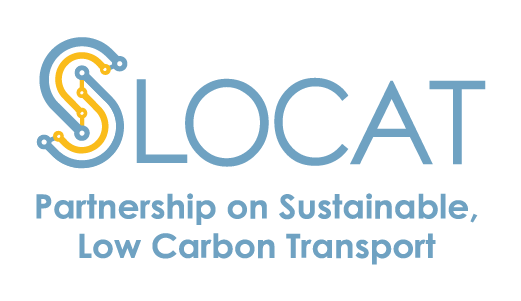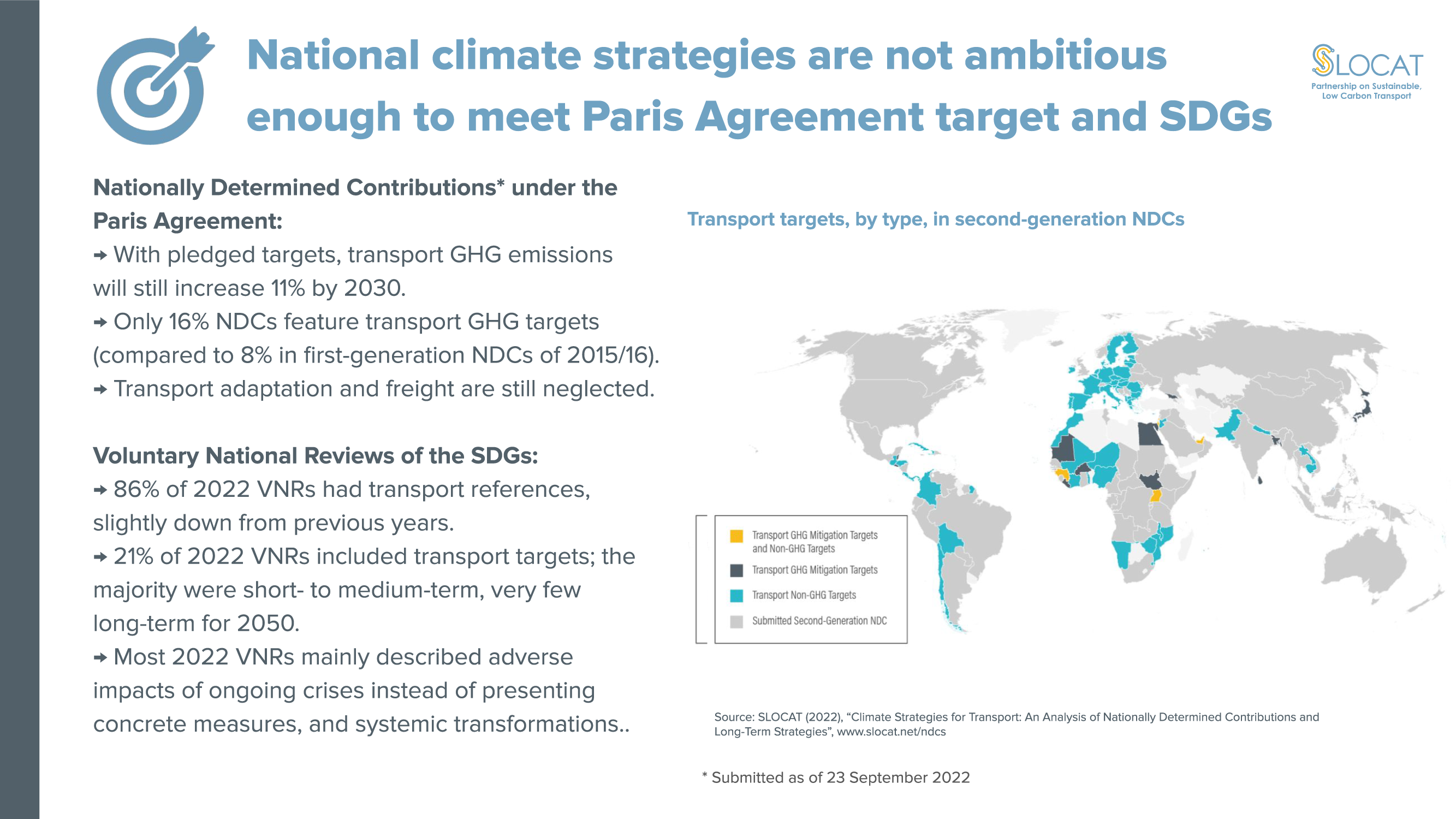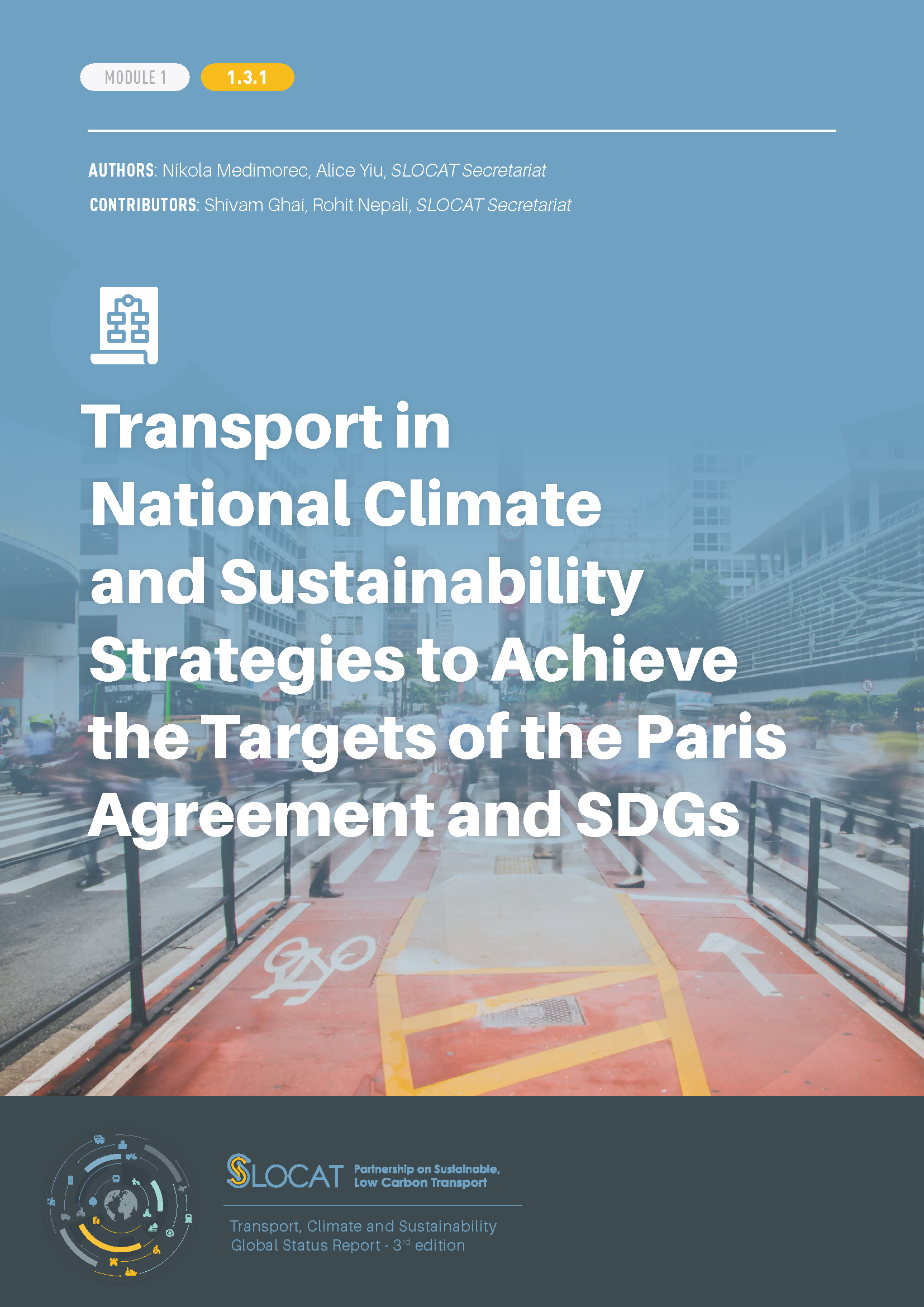-
National Climate and Sustainability Strategies to Achieve the Targets of the Paris Agreement and the SDGs on Transport
- Key Findings
- To achieve the objectives of the Paris Agreement and of the 2030 Agenda on Sustainable Development – including decarbonisation by 2050 and improved accessibility, resilience and sustainability by 2030 – the transport sector must accelerate its transformation immediately.
- The Nationally Determined Contributions (NDCs) submitted as of 23 September 2022 are insufficient to avoid an average temperature increase of 2.5°C by the end of this century.
Nationally Determined Contributions in the framework of the Paris Agreement
- Most countries (169 countries in total) submitted second-generation NDCs before the end of 2022 and strengthened their overall climate ambitions.
- On average, the second-generation NDCs included more transport mitigation and adaptation actions than the first generation of NDCs. Each second-generation NDC featured nearly twice as many transport mitigation actions as did first-generation NDCs.
- The second-generation NDCs also featured twice as many transport targets (109 targets in total in 64 NDCs) as the first-generation ones. However, this does not translate into more impact because targets do not result in absolute reductions in transport emissions.
- Of the second-generation NDCs, 23 (or 16%) had a target for mitigating transport greenhouse gas emissions, mostly for countries in Europe and Africa and for the year 2030; this was up from only 13 first-generation NDCs (or 8%).
- Adaptation is still neglected in transport, as few second-generation NDCs feature transport adaptation targets and actions. In both generations of NDCs, there is little explicit mention of freight-related actions.
- The level of ambition on transport (i.e., targets and actions) in second-generation NDCs remains insufficient to achieve the goals of the Paris Agreement, and implies a further 11% increase in transport greenhouse gas emissions by 2030.
Long-Term Low Emission Development Strategies (LT-LEDS or LTS) in the framework of the Paris Agreement
- By the end of 2022, only a quarter of the world’s countries had developed LTS.
-
All LTS mentioned transport, although only 22% of LTS (13 countries) outlined transport targets, with nearly all having a target year of 2050.
Initiatives and commitments at recent United Nations (UN) climate conference
- During the 2021 UN Climate Change Conference in Glasgow, UK (COP 26), stakeholders launched an unprecedented number of commitments and initiatives on sustainable, low-carbon transport (i.e., zero-emission passenger and freight vehicles, shipping, aviation), and several of these have since expanded in scope and/or signatories.
- At the 2022 UN Climate Change Conference in Sharm El-Sheikh, Egypt (COP 27), the COP 27 Presidency of Egypt launched an initiative on low-carbon transport for urban sustainability that aims to activate systemic change beyond the legacy “mode-first” mindset (i.e., focus on specific transport modes).
Linkages between national planning processes and Paris Agreement mechanisms
- Linkages between national strategies (such as transport development plans, electric vehicle plans and multi-year infrastructure plans) and Paris Agreement mechanisms have been strengthened as more climate strategies reference national strategies.
- The number of countries working on transport decarbonisation strategies has increased since the second edition of this report in 2021. At the sub-national level, several jurisdictions released transport decarbonisation plans.
Voluntary National Reviews (VNRs) in the framework of the 2030 Agenda for Sustainable Development
- The VNRs from 2016 to 2022 revealed consensus on the role of transport as a key contributor to implementation of the Sustainable Development Goals (SDGs). In the first VNR reporting cycle (2016-2019), 92% of VNRs highlighted progress in the transport sector, and 18% of VNRs reported specific targets covering 12 areas in sustainable transport.
- In 2022, 21% of the VNRs (9 out of 42 VNRs) mentioned specific transport targets, up from 20% (9 out of 40) in 2021 and 17% (8 out of 47) in 2020.
- Most of the 2022 VNRs described only the adverse impacts of global issues, without presenting concrete policy measures; when they did, these measures did not fully address the urgent systemic transformations necessary to enable equitable access to transport and mobility for all.
Impacts of global shocks
- Global shocks since 2020 – such as the COVID-19 pandemic and the Russian Federation’s invasion of Ukraine – have put at increased risk any overall progress towards the SDGs and the Paris Agreement goals.
- The COVID‑19 pandemic induced long-lasting negative impacts on urban mobility, land use and transport systems across low-, middle- and high-income countries.
Authors: Nikola Medimorec and Alice Yiu, SLOCAT Secretariat
Contributors: Shivam Ghai, Rohit Nepali, SLOCAT Secretariat


